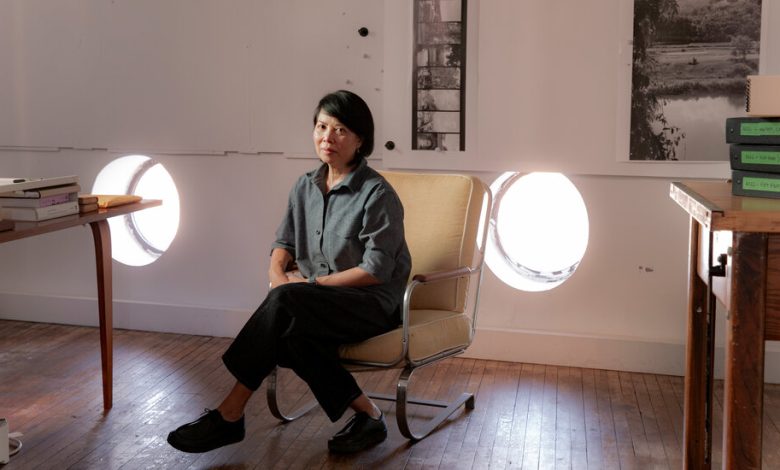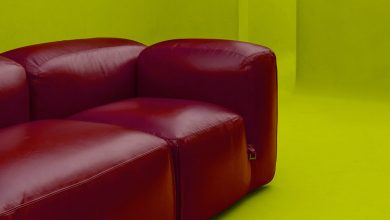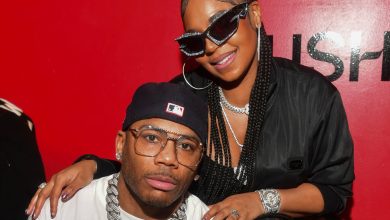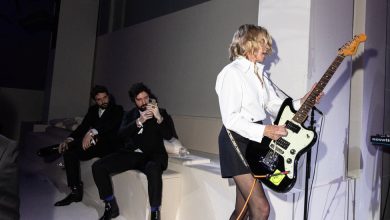An-My Lê Seeks Herself in the Landscape

The artist An-My Lê insists that she doesn’t photograph war. For much of her career, Lê has photographed the many preambles and the long wake of violent combat: Vietnam War re-enactments in the forests of Virginia; training exercises in the California desert for Marines headed to Iraq and Afghanistan; and the American military’s “peacetime” activities around the world. But a straightforward view from the battlefield is not her priority. “I’ve always been interested in finding ways to visualize people’s ideas of war,” Lê says, “whether my own or someone else’s construct.”
Lê was born in Saigon, the former capital of South Vietnam, in 1960, a year of unrest and a failed military coup in the country. Eight years later, the North Vietnamese Army and the communist Vietcong forces launched the Tet Offensive,attacking more than 100 cities, with Saigon as the centerpiece. As a child, the artist learned to cope with the surrounding violence by redirecting her focus. Once, an explosive fell on her Catholic school just 20 minutes before she arrived. While standing across from the smoldering crater that it left behind, she recalls, she concentrated on how great it would be to have time off from her classes. Witnessing war, Lê learned early on, is an experience of emotional contradictions.
In April of 1975, four days before Communist forces captured Saigon, the then-15-year-old Lê escaped on an American military transport plane with her family. They traveled through United States Air Force bases across the Pacific Ocean before landing at Camp Pendleton, in California. She says she did not understand the full gravity and terror of what she lived through until she saw it from a distance, watching news reels at her California high school and studying Vietnam War films and literature in college. The photographs she would go on to make reflect a similar dynamic, typically placing the viewer at some distance from the action, and in this way bringing the scene’s scale and surrounding context to the fore.
She didn’t return to Vietnam until 1994, 19 years later, after receiving a Master of Fine Arts in photography from Yale the year prior. On that trip, she began her landscape series “Viêt Nam.” At the time, she was strongly influenced by the photographers Robert Frank, Stephen Shore and Joel Sternfeld, who all made layered, unglamorous images of American landscapes across the United States. However, “as much as I loved that work,” Lê says, “I couldn’t see myself in it.” While walking through the Red River Delta, near her grandmother’s birthplace, she stopped to photograph a young girl standing in a rice field in Nam Ha during harvest. The resulting, untitled image, which she has described as a “self-portrait,” reveals her tender search for a reflection in the landscape from which she was displaced.
Lê’s more recent works are also imbued with traces of her childhood, and the violence that shaped it. The installation “đô-mi-nô” (2021) features a set of more than 100 jumbo lighters, collected by the artist and arranged on shelves like items in pantry. They are modeled after Zippos that American soldiers carried in Vietnam during the war. Some soldiers used their lighters to set fire to entire villages; some saw them as lucky charmsor amulets. Lê’s lighters feature engravings such as “Why Me,” a peace sign and “Let Me Win Your Heart and Mind or I’ll Burn Your God Damn Hut Down.” Drawing from a family tradition of fiber work, Lê hand-wove cozies that wrap around the objects, softening and protecting the metal. “Someone Else’s War (Gangbang Girl #26)” (2016-23) similarly recontextualizes cultural debris from that era: Lê took screenshots of a pornographic film set in a fictional Vietcong village — starring a group of Black men as American G.I.s and two Asian women (who are not Vietnamese) as local sex workers — and embroidered them into tapestries, with help from her assistants as well as seamstresses in Ho Chi Minh City. The scenes, seemingly devoid of care and cultural nuance, are transformed into spaces where constructions of race, womanhood and wartime memories can be handled and examined collaboratively, each gesture rebuilt with intertwined layers of thread.
For the first time, these works are presented side by side with a selection of Lê’s photographs and films in a career-spanning retrospective, “Between Two Rivers/Giữa hai giòng sông/Entre deux rivières,” currently on view at the Museum of Modern Art in New York. As the title implies, the show tracks Lê’s enduring interest in natural landscapes, ones that are charged yet fluid — and open to multiple translations. In animage from her ongoing series “Silent General”(2015-ongoing), a family cools off in the Rio Grande, sitting directly in the middle of the waterway that runs alongside the Mexican-American border.
On a video call, Lê spoke with me from her Brooklyn studio, a practical room with a large printer, racks of embroidery floss and plenty of empty wall space for hanging prints. As she answered T’s Artist’s Questionnaire, morning light filtered through a row of portholes facing east, making her studio feel like a ship in the sky.
What is your day like? How much do you sleep, and what’s your work schedule?
I have two kids. The youngest one just left for college this fall. This is the first time in a long time that I’ve had so much free time. I’m no longer bound to their schedule — waking up and making breakfast for them. I’m not getting calls about what is for dinner anymore. It has been freeing.
When I’m on the road, I spend my time exploring places and planning, but during recent travels, in the last five or six years, I’ve photographed a lot less. Maybe I have a better sense of what could possibly work, so I don’t have to expose so much film. When I’m not on the road, teaching or photographing, I’m at the studio. I spend an enormous amount of time working on editing and color correcting my inkjet prints. I agonize over contrast, the saturation of greens in grass and plants, color casts in the skies and the density of someone’s skin.
How many hours of creative work do you think you do in a day?
Some people make a distinction between busywork and creative work, but I think I do my most creative work when I’m not actively trying to — when I’m out walking or cooking, chopping vegetables. In that sense, maybe I’m always working.
When I’m out photographing,if accessing a site or a subject is particularly difficult, I have to make calls almost 24/7 to make that picture happen. I wish my process was more systematic. I’ve always envied the life of a painter. You wake up and go to the studio. And then you have a few hours for reading and lunch. It sounds really nice.
What’s the first piece of art you ever made?
When I was 8, we moved to Paris, briefly. My mom received a scholarship to do her Ph.D. there in 1968. This was right after the Tet Offensive. She took my brothers and me with her while my dad stayed in Vietnam. We lived with my grandmother and I shared a room with her.I learned how to crochet and knit from my grandmother.
During that time, I received a Barbie doll and the clothes didn’t really make sense to me so I decided to create new ones. I crocheted this minimal, monochromatic skirt and shirt for the doll. I didn’t work from a pattern — I was so proud of myself. I would say that was my first piece of art. I don’t come from a family of artists. We don’t draw or paint. All the women crochet, do craft work and knit. Cooking, too. They’re all very committed to cooking.
What’s the worst studio you ever had?
When I was at Yale in the early ’90s for my M.F.A., photographers weren’t given studios. The studio was the world. This was the Walker Evans and Garry Winogrand approach to photography. We had dark rooms instead. Any studio would have been a good studio. There’s no such thing as a bad studio.
What’s the first work you ever sold? For how much?
I may have forgotten some small things, but the first substantial one was something I sold to a close friend from college. Her name is Jane. She was a very successful managing director on Wall Street, one of the few women who dealt with junk bonds. This was in ’94. She bought three prints at $400 each and I gifted her a print in addition to those. It was a lot of money and it helped with one of my trips to Vietnam. I was the first artist she ever collected. We’re still friends.
When you start a new piece, where do you begin?
I usually have a question or a curiosity about something. For photographs, it’s always the question of where do you go? What is the place that would have the potential for possible answers? For objects and embroidery, it’s a different process — one I’m trying to understand. It might be seeing something and really liking the way it looks or feels. The way it sits, the volume, the weight. For example, the lighters [in the “đô-mi-nô” series] are functional but somehow carry meaning beyond their function.
How do you know when you’re done?
I start losing steam and become distracted by and curious about other things. Sometimes, you can’t find the energy in the middle of the process, and you have to talk yourself out of that. But when it ends, you just know.
How many assistants do you have?
For a long time, I worked alone. Except in the field — it’s a lot faster, especially while working in a military context, to have an assistant in the field. I once had an assistant in the darkroom because I was pregnant, and I didn’t want to inhale the fumes. Leading up to my survey show at the Carnegie Museum of Art in 2020, and more recently, the MoMA exhibition, I realized I needed a lot more help in the studio to prepare for both. I now have three part-time assistant, all young artists. The shows would not have happened without their support.
What music do you play when you’re making art?
I love listening to podcasts and, right now, the idiosyncratic electronic musician Aphex Twin, but I only listen to something when I do repetitive busywork. On the road, when I’m out photographing, there’s so much noise: people talking, things exploding, the wind blowing. But as soon as I photograph, I tune out; I don’t hear anything.
When did you first feel comfortable saying you’re a professional artist?
The word “professional” is a little odd, I think. I felt comfortable saying I was an artist when I stopped caring about standards of success. That is when I knew I was committed. I knew it was for real.
Is there a meal you eat on repeat when you’re working?
No, not really. On the road, food is a big deal for me. It’s the only reward after working really hard. Sometimes, I don’t know where I’m sleeping that night. It’s so stressful. Finding a great restaurant or market is key. Sometimes, I’ll plan an itinerary around a specific culinary destination.
Are you bingeing any shows right now?
No, but I love “Slow Horses.” I love spy thrillers. I love that they involve balancing geopolitical powers, and that people are trying to resolve things without turning to all-out war. I also love the idea of someone not seeming like who they are —being smarter and more skilled than they project.
How often do you talk to other artists?
Between teaching and being around my husband, John Pilson, who is an artist, I’m always talking to them.
What do you do when you’re procrastinating?
I watch those videos of Pasta Grannies, all of those old Italian women making pasta.
I love them.
They’re mesmerizing. I’ll also procrastinate by wandering to the farmers’ market or a well-stocked grocery store and planning a meal.
What’s the last thing that made you cry?
My mom passed away a year ago, in November, and around that time this year something reminded me of the day she fell and went to the hospital. I was doing laundry and pulling clothing out of the dryer. I took the time folding everyone’s T-shirts squarely and neatly, the way she always did. That made me cry. I really miss her.
What do you usually wear when you work?
In the field it’s a very complex thing. Whether you’re working in Bahrain or the South Pole Station, you have to wear the right clothes. There are so many other things going on, so you want to be comfortable.I’m fascinated by high-tech military gear and clothing, even though I don’t work with the military anymore.
In the studio, I love wearing comfortable clothes. Once in a while, I splurge on clothes by Margaret Howell, a British designer who makes very minimalist clothes thatare great for the studio.
What’s your worst habit?
Can I have two? Falling asleep in front of the TV. It won’t even be 9 o’clock yet. It’ll be like 8:30. And then I’ll wake up and say, “What just happened?” The other bad habit is wanting to give a friend advice when they just need to vent.
What embarrasses you?
Compliments, unfortunately.
Do you exercise?
I grew up doing a lot of martial arts and ballet. I switched to yoga because of my schedule and obligations. I also discovered this app that allows me to interact with a personal trainer. My trainer is named Jack, same as my son, and by chance, he is Vietnamese. He gives me a weekly schedule. We send each other messages while I’m exercising. It helps me be accountable. I’ve been doing this for about a year now, and I exercise four or five times a week.
What are you reading?
I just started reading an advance copy of Vinson Cunningham’s first novel, “Great Expectations.” I love it.
What’s your favorite artwork by someone else?
It’s “Panoramic View of the Palace and Gardens of Versailles”(1818-19), by John Vanderlyn. I told my friend Susan Kismaric, a retired photo curator, that I was interested in doing an installation that was photographic, immersive and 360 degrees for the MoMA show. She immediately took me to the Met to see that piece. It’s been very influential to me. You walk into a dimly lit, circular room to see the painting. The experience is transporting. I’ve gone back a lot to look at it. You must go.




